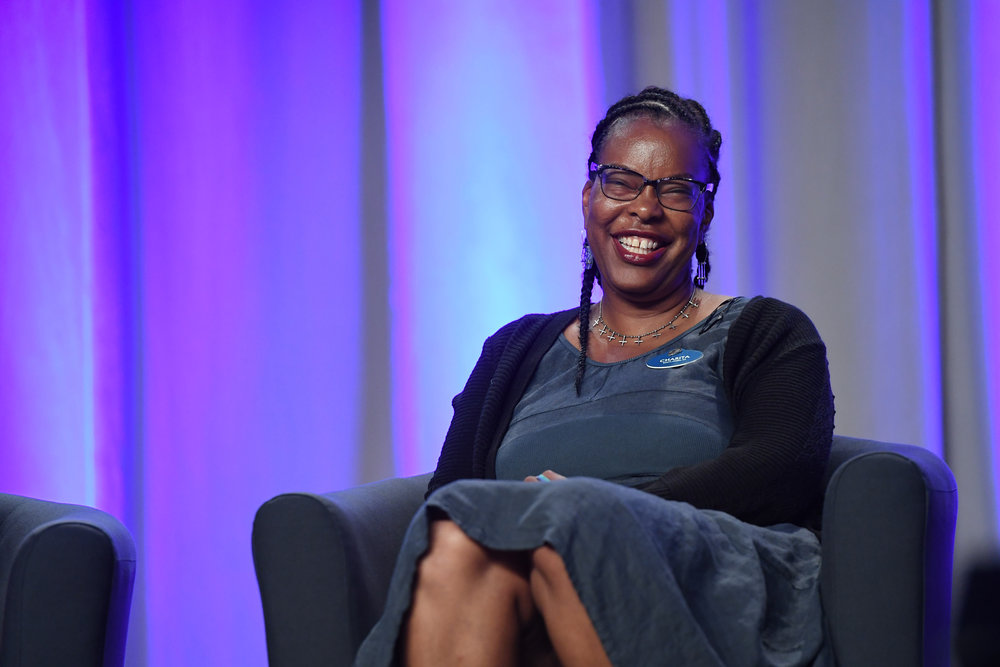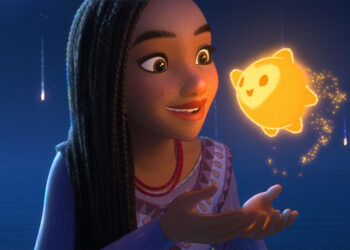The Women of Imagineering panel featured seven inspiring women, each working in different areas of Walt Disney Imagineering.

Host Kathy Mangum (far left), Senior Vice President of WDI Atlantic Region, introduced the talented women of the panel (from second chair, left to right): Andrea Lawler, ride engineer at WDI and screenwriter outside Disney; Charita Carter, Creative Producer and lead producer on the newly announced Mickey Mouse ride; Jodi McLaughlin, Executive Producer; Wendy Anderson, Executive Creative Producer for Disney Parks Live Entertainment; Marnie Burgess, Project Management Executive; Sarah Thacher, WDI Research and Development; and Laura Cabo, Architectural Design Studio Executive.
Walt Disney Imagineering covers several departments and skills, not only engineering, bringing in talent from various other career paths. Carter worked first as an accountant, at a company across the street from Walt Disney Imagineering. When the financial company went east, she went to Disney, starting out as a financial analyst, eventually for the creative team at WDI. From there, she had the opportunity to join the ideation area of Imagineering; Carter has been a producer for four years.
Lawler, who pursued writing in university, also had a passion for maths and science, and wanted to find a way to combine her talents. With Walt Disney Imagineering’s focus on storytelling within all of their Parks & Resort creations, Lawler’s talents were combined in a unique and fulfilling way. She began in robot animation, working to bring animatronics to a lifelike and believable level, just like characters in a screenplay.
“When we first think of Disney, we think of stories.”
Anderson was a theatre director, often directing shows in unusual or unique environments. Her skillset in theatre turned out to be near-parallel to the skills required as a creative producer in Imagineering; worldbuilding was at the core of each career, creating immersive environments and using them as a stage. Creative producer for three years, she is now the lead creative producer for the upcoming Beauty and the Beast show for the Disney Cruise Line.
Cabo worked originally for a small design group, one that got lucky; the group won a contest to design a large resort, and did several similar projects afterward. Cabo got Disney’s attention. She found a collegial atmosphere at WDI, one full of collaborative and fun projects. As with Lawler, Cabo discovered WDI’s storytelling focus, leading her to architectural design with heightened and more dramatic skill.
Thacher was also found by Imagineering, brought into research and development from a small group that worked with immersive entertinment. She remembers finally being able to show her parents tangible products that she had created with WDI.
Burgess worked first on construction at Animal Kingdom, which gave her a broad look at the components that come together at WDI. She pursued project management, a department often considered male-dominated as Mangum points out, for similar reasons; she has been able to work in multiple projects in multiple ways, getting involved with many facets of WDI.
“The passion, the attention to detail, the timeless dedication…”
McLaughlin helped bring Disney to mainland China, working in production on Shanghai Disneyland. There she was able to grow and encourage a new generation of Imagineers. Through an internship program, as McLaughlin remembers, a group of five women joined the creative team, thereby finding a way to make their interest in the arts much more than just a hobby; three of the women were officially hired by Disney, proving to themselves and their parents that they could make a career in the arts.
“I was inspired by them, the way they think about design, the way they think about color…”
Lawler, too, appreciated the many venues for outreach available for WDI. Outside scientists and students brought in to Imagineering were taught how their skills could be applied in newe and unconventional ways. This lesson was prominent when Lawler participated in an advertisement campaign aimed toward younger children, especially girls, that promoted worldbuilding with LEGO; Lawler aimed to show kids that engineering, worldbuilding, and design could apply to enhance storytelling in their play.

Carter remembers her first task as a financial analyst was to take a pysical inventory of every single asset in Walt Disney Imagineering; the task was extensive but allowed Carter to explore Imagineering and talk with all kinds of Imagineers, motivated by curiosity and a desire to learn. This social exploration through WDI brought her more opportunity to branch out into the creative side. Her first project as lead producer was the Parks and Resorts pavilion for the first D23 Expo in 2009.
“As those opportunities come to you, take full advantage to learn as much as you can.”
Opportunities in WDI don’t just push the skills of Imagineers to a new level, they help to expand an Imagineer’s abilities. It is a culture of “Yes, and,” determined to find ways to make ideas happen, without negativity or dismissal. WDI is about collaboration and teamwork, teaching and assisting and learning from each other with judgement. For all of these women, WDI has been an openhearted place in a corporate culture.
“We all look at we do as what we give to the guests… We’re all on the same team.”
— Burgess
“There is an expectation that we’re all storytellers.”
— Wendy Anderson

Cabo adds that each Imagineer goes through unique training, including something called ‘Toy Box training,’ which trains Imagineers to stop creative blocks. Cabo calls one of the points ‘greenhousing,’ where ideas are taken on and given a chance to grow.
“No idea is a bad idea.”
The women also discuss highlights of their careers so far. Anderson remembers working with Research and Development on a vertical wind tunnel in the middle of the parking lot as a unique experience. She also recalls the thrill of being on the Star Wars Episode VII set, sitting in the Millennium Falcon.
Burgess loves visiting the parks with her children, and remembers he son telling everyone in line that his “mommy built Disneyland.” In a similar vein, Cabo often goes into the parks with her team, about twice a year, to walk through attractions before guests arrive.
For these Imagineers, WDI is three-dimensional storytelling, full of the Disney magic we know and love in the films, and that we have come to expect from the Disney Parks and Resorts.






